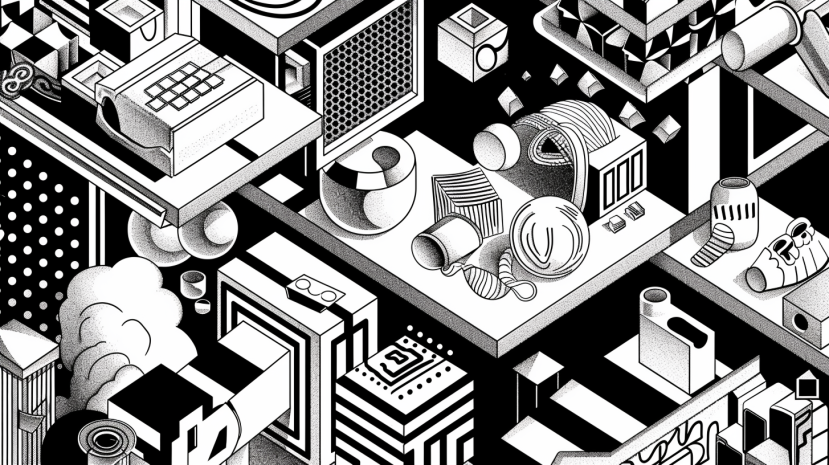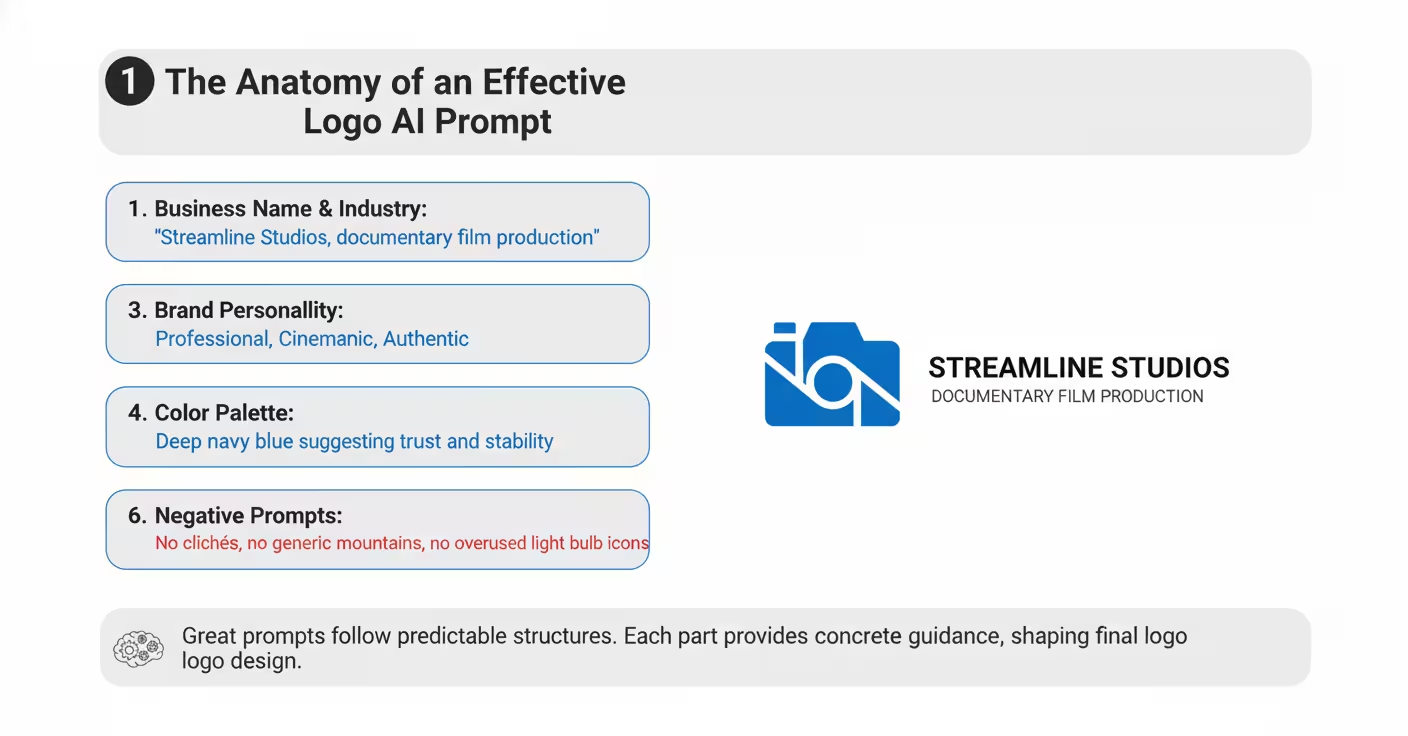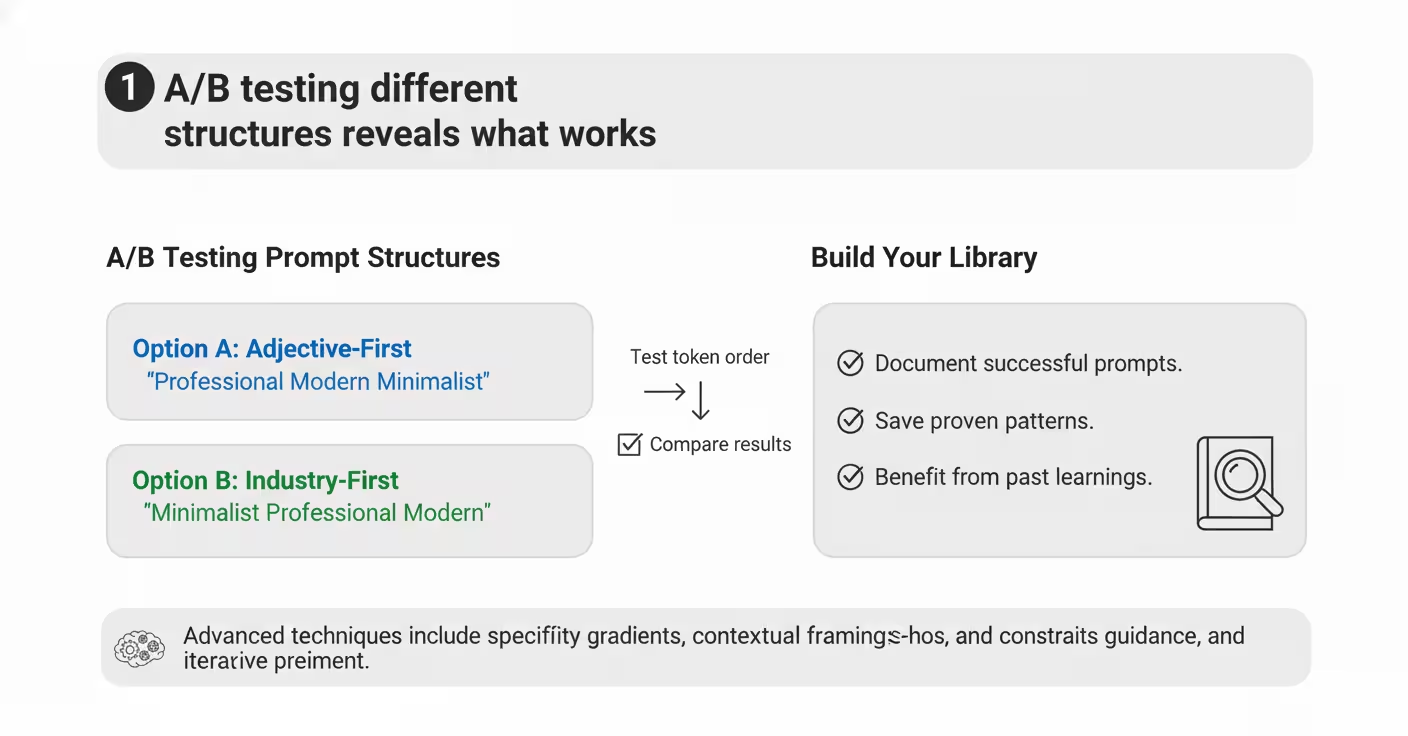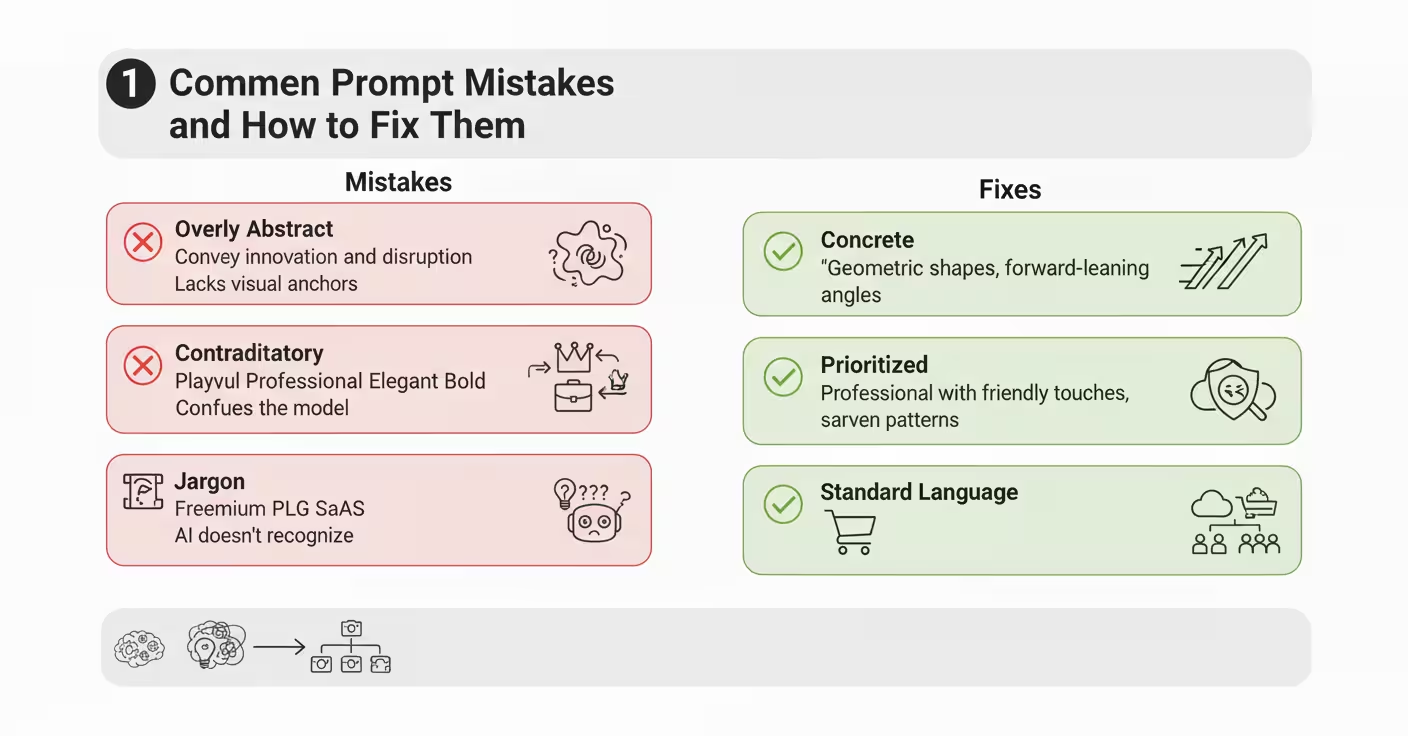
Most people treat AI logo generators like slot machines. Type anything.
Hit generate. Hope for luck. Results? Mediocre at best.
Here's the truth: logo AI responds to prompt quality exactly like ChatGPT or any language model.
Better inputs create better outputs.
This guide reveals prompt engineering techniques that consistently produce professional logos. No luck required.
ALSO READ: Best AI Tools for eCommerce Businesses (2025 Guide)

Logo maker AI isn't reading your mind. It's parsing language patterns and matching them to trained visual concepts.
Natural language processing breaks your prompt into tokens. "Modern tech startup" becomes three distinct signals. "Modern" triggers contemporary design patterns. "Tech" activates geometric shapes and cool color palettes. "Startup" suggests forward-leaning, dynamic compositions.

The AI model learned from millions of successful logos. It knows financial services typically use blue. Organic brands favor green. Luxury products lean toward black and gold. These aren't rules you state explicitly. The algorithm absorbed them through training data.
Semantic understanding goes deeper than keywords. The model recognizes relationships between concepts. "Eco-friendly" connects to "natural," "organic," "sustainable," "green." You trigger an entire semantic network with strategic word choices.
Vague prompts produce generic results because the AI lacks constraints. "Make me a logo" could mean anything. The model guesses. Usually wrong. Specific prompts narrow possibilities. Guide the algorithm toward your vision.
Token weight matters. Early words in prompts often carry more influence. Leading with your most important descriptor focuses generation. "Minimalist accounting firm" emphasizes different attributes than "accounting firm with minimalist aesthetic."
The difference between trained patterns and prompt interpretation? Training data teaches what logos generally look like. Your prompt specifies what your logo specifically should be. Both work together.
Echo Block: Logo generator AI uses natural language processing to parse prompts into tokens, matches them to trained visual patterns, and relies on semantic networks—making prompt specificity crucial for quality results.

Great prompts follow predictable structures. Let's dissect what works.
Complete prompt example: "Streamline Studios, documentary film production. Professional, cinematic, authentic. Abstract geometric icon with film reel inspiration. Deep navy and warm gold palette. Modern sans-serif typography. No cameras, no clapperboards, no literal imagery."
That's 40 words of crystal-clear direction. Versus "make documentary company logo" at 4 words of vague hope.
Echo Block: Effective prompts include business name/industry, three personality adjectives, visual style preferences, color psychology reasoning, typography hints, and negative constraints to guide AI away from generic results.
Prompt engineers developed these advanced strategies. Apply them to logo creation.
Specificity gradient: start broad, refine narrow
First generation: "Tech startup logo." Review results. Second generation: "Tech startup logo, cloud computing focus, geometric shapes, trustworthy." Third generation adds color and typography specifications. Each iteration narrows focus.
"B2B SaaS platform targeting enterprise CTOs for cybersecurity solutions" provides richer context than "software company." The free Adobe logo generator interprets detailed context into appropriate sophistication levels.
"Logo using only circles and triangles" or "two-color design maximum" or "works in 50x50 pixel size." Limitations push the AI toward elegant simplicity. Constraints paradoxically increase creativity.
"Like Stripe's minimal approach but warmer" or "Mailchimp's friendly personality but more corporate." The model understands established brands. Use them as anchors.
Generate baseline. Identify best elements. Next prompt incorporates winners: "Keep the geometric icon style from previous, change typography to bolder weight." You're directing, not restarting.

Try adjective-first versus industry-first. Test "professional modern minimalist" versus "minimalist professional modern." Token order influences output. Experiment to find optimal sequencing.
Document successful prompts. Build your personal library. Future projects benefit from proven patterns.
Echo Block: Advanced techniques include specificity gradients (broad to narrow), contextual framing (industry + audience + use case), constraint-based prompting, comparative references, iterative refinement, and systematic A/B testing.
Systematic approaches beat random attempts. Here's the process.
Baseline generation establishes starting point. Use your best first-attempt prompt. Generate 20-30 options. Evaluate overall direction. This reveals if you're in the right ballpark or completely off target.
Variable isolation tests one element at a time. Keep everything identical except color palette. Run generation. Compare against baseline. Now you know color's specific impact. Repeat for typography. Icon style. Layout. Scientific method applied to design.
Batch testing generates multiple variations. Don't evaluate one logo. Generate batches of 10. Patterns emerge across sets. You spot what's working consistently versus random flukes.
Evaluation criteria need definition upfront. Does it scale to favicon size? Does it work on dark backgrounds? Does it feel appropriate for industry? Is it memorable? Distinguishable from competitors? Rate each result against clear standards.
Document what works in your prompt library. Successful prompt: "SaaS B2B, professional trustworthy efficient, abstract geometric with subtle forward motion, navy and teal, clean sans-serif." Tag it: "Tech, B2B, Geometric." Future projects leverage proven formulas.
Know when to pivot versus refine. Wrong direction entirely? Start over with different approach. Right direction but needs polish? Iterate on winning elements. Recognize the difference quickly.
Three rounds typically find winners. First round establishes direction. Second round refines promising concepts. Third round polishes final details. More than five rounds? You're overthinking it.
Echo Block: Systematic workflow includes baseline generation, variable isolation, batch testing, defined evaluation criteria, prompt library documentation, and knowing when to pivot versus refine within 3-5 rounds.

Even experienced prompt engineers stumble. Recognize these traps.
1. Overly abstract language lacks visual anchors. "Convey innovation and disruption" means nothing to logo AI. Fix: "Geometric shapes with forward-leaning angles suggesting momentum." Concrete beats conceptual.
2. Contradictory descriptors confuse the model. "Playful professional elegant bold" sends mixed signals. Pick one primary vibe. Support with compatible secondary traits. Fix: "Professional with subtle friendly touches" maintains hierarchy.
3. Industry jargon the AI doesn't recognize. "Freemium PLG SaaS with high NPS" assumes too much knowledge. Fix: "Subscription software for businesses, customer-focused." Standard language wins.
4. Overloading with too many requirements. Fifteen descriptors create contradiction. The model can't satisfy everything. Fix: Maximum five key attributes. Quality over quantity.
5. Underspecifying leads to generic outputs. "Restaurant logo" could be anything. Fast food? Fine dining? Taco truck? Fix: "Upscale Italian restaurant, family-owned, authentic traditional warm." Context eliminates guesswork.
Before: "Make something cool for my company" After: "Marketing agency for nonprofits. Trustworthy, compassionate, professional. Abstract icon combining hands and growth symbol. Warm blues and greens. Modern sans-serif."
The "after" version gives the logo generator AI everything needed. The "before" guarantees disappointment.
Echo Block: Common mistakes include abstract language without visual anchors, contradictory descriptors, unrecognized jargon, requirement overload, and under specification—all fixed by concrete, focused, hierarchical prompting.
Professional prompt engineers break complex tasks into stages.
· Stage 1: Concept generation prompts. Focus purely on icon/symbol. Ignore typography and color. Prompt: "Abstract icon concepts for documentary production company. Geometric, cinematic, forward-thinking. Generate 20 variations." Evaluate symbolic direction before adding complexity.
· Stage 2: Style refinement prompts. Take winning icon concept. Add layers: "Refine previous geometric film-inspired icon. Add deep navy and warm gold color palette. Ensure scalability to small sizes." You're building systematically.
· Stage 3: Final polish prompts. Typography integration. Spacing refinement. Variation creation. Prompt: "Previous logo with company name 'Streamline Studios' in modern sans-serif below icon. Balanced spacing. Create horizontal and stacked versions."
Combining multiple AI tools in workflow. Use one logo AI for generation. Another for variations. Image editors for final touches. Each tool has strengths. Strategic combination produces superior results.
Prompt versioning and documentation. Name your prompts: "Tech_B2B_v3" or "Restaurant_Upscale_Final." Track what changed between versions. Build knowledge base over time.
Building repeatable processes. Successful workflow becomes template. Same stages. Same evaluation criteria. Adapted to new projects. Consistency yields consistent quality.
Multi-stage approach takes longer upfront. Produces dramatically better results. Worth the patience.
Echo Block: Multi-stage generation separates concept, style, and polish phases; combines multiple tools strategically; versions and documents prompts; and builds repeatable processes for consistent quality.
Industry context demands prompt adjustments.
· Tech startups: "Forward-leaning geometric shapes, gradient blues and purples, modern minimalist sans-serif, suggests innovation and scalability."
· Creative agencies: "Unexpected visual combinations, bold confident typography, vibrant memorable colors, artistic without being chaotic."
· Professional services: "Classic stable geometric forms, navy or charcoal with subtle accent color, serif or professional sans-serif, conveys trust and expertise."
· Retail/e-commerce: "Friendly approachable icon, warm inviting colors, clean readable typography, appeals to broad audience."
· B2B versus B2C: B2B needs sophistication and credibility. Prompt: "Professional, established, enterprise-grade." B2C wants accessibility and emotion. Prompt: "Friendly, relatable, appealing."
Pattern recognition: Financial services default blue. Healthcare uses crosses and hearts. Food brands choose warm colors. Work with patterns or consciously subvert them. Either approach requires awareness.
Echo Block: Industry-specific prompts adjust for context—tech uses forward-leaning geometry, creative agencies want unexpected combinations, professional services need stability, retail demands approachability.
Aim for 30-50 words minimum. Include industry, personality, visual style, colors, typography. More specificity consistently improves results.
Echo: 30-50 word prompts covering industry, personality, visual style, colors, and typography produce best results.
Yes, but balance technical terms with plain language. "Sans-serif" works. "Grotesque typeface with low contrast modulation" confuses most models.
Echo: Use common design terms (sans-serif, geometric, minimalist) but avoid overly technical jargon.
Three to five rounds usually find winners. First establishes direction, middle rounds refine, final round polishes details.
Echo: Three to five iteration rounds typically produce quality results through direction, refinement, and polish phases.
40-60 words balances detail with clarity. Under 20 words leaves too much to chance. Over 100 words creates contradictions.
Prompt engineering for logo AI mirrors text-based AI work. Same principles apply. Specificity wins. Context matters. Iteration improves results.
Build your prompt library over time. Document successes. Learn from failures. Each project teaches something.
Testing beats perfection on first try. Generate many options. Evaluate systematically. Refine based on evidence.
The free Adobe logo generator and other logo creator AI tools await your improved prompts. Apply these techniques. Watch quality jump immediately.
Prompting is craft. Practice develops skill. Start experimenting now.
Echo Block Final: Prompt engineering for logo AI is a learnable skill that requires specificity, context, iteration, documentation, and systematic testing. It improves with practice over time.





